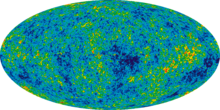
Redshift

In physics, redshift is a phenomenon where electromagnetic radiation (such as light) from an object undergoes an increase in wavelength. Whether or not the radiation is visible, 'redshift' means an increase in wavelength, equivalent to a decrease in wave frequency and photon energy, in accordance with, respectively, the wave and quantum theories of light.For motion completely in the radial or line-of-sight direction: 1 + z = γ ( 1 + v ∥ c ) = 1 + v ∥ c 1 − v ∥ c {displaystyle 1+z=gamma left(1+{frac {v_{parallel }}{c}} ight)={sqrt {frac {1+{frac {v_{parallel }}{c}}}{1-{frac {v_{parallel }}{c}}}}}} z ≈ v ∥ c {displaystyle zapprox {frac {v_{parallel }}{c}}} for small v ∥ {displaystyle v_{parallel }} For motion completely in the transverse direction: 1 + z = 1 1 − v 2 c 2 {displaystyle 1+z={frac {1}{sqrt {1-{frac {v^{2}}{c^{2}}}}}}} In physics, redshift is a phenomenon where electromagnetic radiation (such as light) from an object undergoes an increase in wavelength. Whether or not the radiation is visible, 'redshift' means an increase in wavelength, equivalent to a decrease in wave frequency and photon energy, in accordance with, respectively, the wave and quantum theories of light. Neither the emitted nor perceived light is necessarily red; instead, the term refers to the human perception of longer wavelengths as red, which is at the section of the visible spectrum with the longest wavelengths. Examples of redshifting are a gamma ray perceived as an X-ray, or initially visible light perceived as radio waves. The opposite of a redshift is a blueshift, where wavelengths shorten and energy increases. However, redshift is a more common term and sometimes blueshift is referred to as negative redshift.
